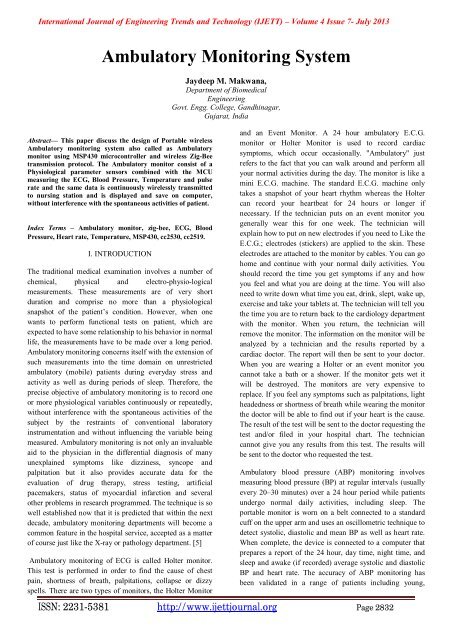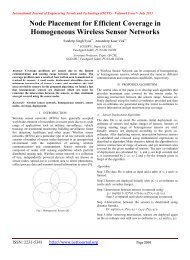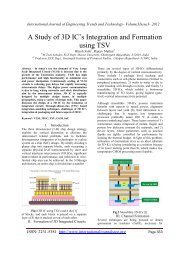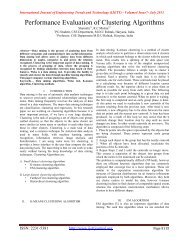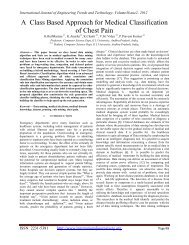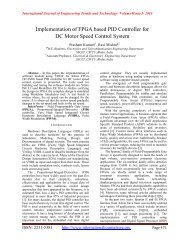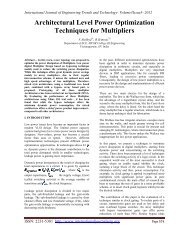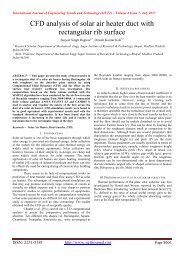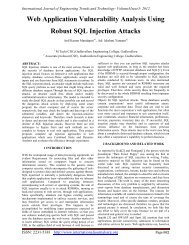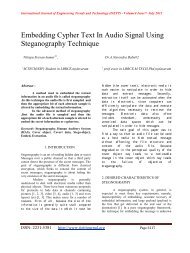Ambulatory Monitoring System - IJETT-International Journal of ...
Ambulatory Monitoring System - IJETT-International Journal of ...
Ambulatory Monitoring System - IJETT-International Journal of ...
You also want an ePaper? Increase the reach of your titles
YUMPU automatically turns print PDFs into web optimized ePapers that Google loves.
<strong>International</strong> <strong>Journal</strong> <strong>of</strong> Engineering Trends and Technology (<strong>IJETT</strong>) – Volume 4 Issue 7- July 2013<strong>Ambulatory</strong> <strong>Monitoring</strong> <strong>System</strong>Jaydeep M. Makwana,Department <strong>of</strong> BiomedicalEngineeringGovt. Engg. College, Gandhinagar,Gujarat, IndiaAbstract— This paper discuss the design <strong>of</strong> Portable wireless<strong>Ambulatory</strong> monitoring system also called as <strong>Ambulatory</strong>monitor using MSP430 microcontroller and wireless Zig-Beetransmission protocol. The <strong>Ambulatory</strong> monitor consist <strong>of</strong> aPhysiological parameter sensors combined with the MCUmeasuring the ECG, Blood Pressure, Temperature and pulserate and the same data is continuously wirelessly transmittedto nursing station and is displayed and save on computer,without interference with the spontaneous activities <strong>of</strong> patient.Index Terms – <strong>Ambulatory</strong> monitor, zig-bee, ECG, BloodPressure, Heart rate, Temperature, MSP430, cc2530, cc2519.I. INTRODUCTIONThe traditional medical examination involves a number <strong>of</strong>chemical, physical and electro-physio-logicalmeasurements. These measurements are <strong>of</strong> very shortduration and comprise no more than a physiologicalsnapshot <strong>of</strong> the patient’s condition. However, when onewants to perform functional tests on patient, which areexpected to have some relationship to his behavior in normallife, the measurements have to be made over a long period.<strong>Ambulatory</strong> monitoring concerns itself with the extension <strong>of</strong>such measurements into the time domain on unrestrictedambulatory (mobile) patients during everyday stress andactivity as well as during periods <strong>of</strong> sleep. Therefore, theprecise objective <strong>of</strong> ambulatory monitoring is to record oneor more physiological variables continuously or repeatedly,without interference with the spontaneous activities <strong>of</strong> thesubject by the restraints <strong>of</strong> conventional laboratoryinstrumentation and without influencing the variable beingmeasured. <strong>Ambulatory</strong> monitoring is not only an invaluableaid to the physician in the differential diagnosis <strong>of</strong> manyunexplained symptoms like dizziness, syncope andpalpitation but it also provides accurate data for theevaluation <strong>of</strong> drug therapy, stress testing, artificialpacemakers, status <strong>of</strong> myocardial infarction and severalother problems in research programmed. The technique is sowell established now that it is predicted that within the nextdecade, ambulatory monitoring departments will become acommon feature in the hospital service, accepted as a matter<strong>of</strong> course just like the X-ray or pathology department. [5]<strong>Ambulatory</strong> monitoring <strong>of</strong> ECG is called Holter monitor.This test is performed in order to find the cause <strong>of</strong> chestpain, shortness <strong>of</strong> breath, palpitations, collapse or dizzyspells. There are two types <strong>of</strong> monitors, the Holter Monitorand an Event Monitor. A 24 hour ambulatory E.C.G.monitor or Holter Monitor is used to record cardiacsymptoms, which occur occasionally. "<strong>Ambulatory</strong>" justrefers to the fact that you can walk around and perform allyour normal activities during the day. The monitor is like amini E.C.G. machine. The standard E.C.G. machine onlytakes a snapshot <strong>of</strong> your heart rhythm whereas the Holtercan record your heartbeat for 24 hours or longer ifnecessary. If the technician puts on an event monitor yougenerally wear this for one week. The technician willexplain how to put on new electrodes if you need to Like theE.C.G.; electrodes (stickers) are applied to the skin. Theseelectrodes are attached to the monitor by cables. You can gohome and continue with your normal daily activities. Youshould record the time you get symptoms if any and howyou feel and what you are doing at the time. You will alsoneed to write down what time you eat, drink, slept, wake up,exercise and take your tablets at. The technician will tell youthe time you are to return back to the cardiology departmentwith the monitor. When you return, the technician willremove the monitor. The information on the monitor will beanalyzed by a technician and the results reported by acardiac doctor. The report will then be sent to your doctor.When you are wearing a Holter or an event monitor youcannot take a bath or a shower. If the monitor gets wet itwill be destroyed. The monitors are very expensive toreplace. If you feel any symptoms such as palpitations, lightheadedness or shortness <strong>of</strong> breath while wearing the monitorthe doctor will be able to find out if your heart is the cause.The result <strong>of</strong> the test will be sent to the doctor requesting thetest and/or filed in your hospital chart. The techniciancannot give you any results from this test. The results willbe sent to the doctor who requested the test.<strong>Ambulatory</strong> blood pressure (ABP) monitoring involvesmeasuring blood pressure (BP) at regular intervals (usuallyevery 20–30 minutes) over a 24 hour period while patientsundergo normal daily activities, including sleep. Theportable monitor is worn on a belt connected to a standardcuff on the upper arm and uses an oscillometric technique todetect systolic, diastolic and mean BP as well as heart rate.When complete, the device is connected to a computer thatprepares a report <strong>of</strong> the 24 hour, day time, night time, andsleep and awake (if recorded) average systolic and diastolicBP and heart rate. The accuracy <strong>of</strong> ABP monitoring hasbeen validated in a range <strong>of</strong> patients including young,ISSN: 2231-5381 http://www.ijettjournal.org Page 2832
<strong>International</strong> <strong>Journal</strong> <strong>of</strong> Engineering Trends and Technology (<strong>IJETT</strong>) – Volume 4 Issue 7- July 2013elderly, pregnant and obese subjects (provided the correctsize cuff is used). <strong>Ambulatory</strong> BP monitoring is safe and isnot usually associated with complications. Occasionallyedema or petechiae <strong>of</strong> the upper arm or bruising under theinflating cuff may occur. Modern ABP devices are quiet,lightweight and easy to wear, but inflation <strong>of</strong> the cuff maycause some transient discomfort, particularly in people withhypertension or when multiple readings are triggered due toerrors in measurement. <strong>Ambulatory</strong> BP measurementsduring the night may disturb sleep; potentially requiringretesting if there are poor nocturnal BP measurements. [8]<strong>Ambulatory</strong> BP monitoring provides a more reliablemeasure <strong>of</strong> a patient’s BP than isolated clinic measures andis not subject to the ‘white-coat effect’, which canoverestimate BP, particularly in susceptible patients, Whileclinic measurement <strong>of</strong> BP is useful for screening, and in themanagement <strong>of</strong> suspected and true hypertension.<strong>Ambulatory</strong> BP and home BP measurements addconsiderably to the accurate diagnosis <strong>of</strong> hypertension andthe provision <strong>of</strong> optimal care. Recent recommendationsfrom expert groups such as the United Kingdom’s NationalInstitute for Health and Clinical Excellence stronglyadvocate wider use <strong>of</strong> ABP monitoring in the diagnosis andmanagement <strong>of</strong> hypertension. [8]II.WIRELESS TRANSMISSION METHODMany <strong>of</strong> the wireless monitoring system currently beingproduced use Bluetooth networking systems, which is thefirst task group <strong>of</strong> the IEEE 802.15. There are threeadvantages to using Bluetooth over other low-power PLANsystems:1. High frequency-to-noise ratio (up to -104dB receiversensitivities, and transmission strengths <strong>of</strong> 23dBm or more)2. Capable <strong>of</strong> high data rates, theoretically up to 2.1 Mbit/s(Bluetooth 2.0)3. Bluetooth technology is present in many cellular phones,PDAs, and notebook computers, making any Bluetoothenableddevice very technologically compatibleBluetooth is also a very mature technology, with a multitude<strong>of</strong> chipsets available from many vendors and well-exploredtransmission and encryption s<strong>of</strong>tware. However, it sharesthe downsides <strong>of</strong> all PLAN systems, which include shortrangeeffectiveness and weakness towards interference, as itshares the 2.4GHz band with the higher-power 802.11WLAN traffic. Bluetooth also possess a number <strong>of</strong>additional disadvantages specific towards our needs. First,Bluetooth transceiver chips are somewhat high-power forthis application; up to 190ma during transmission19, andeven with a low duty cycle, current draw is still higher thanwould be preferred. Second, the protocol stack for Bluetoothtransmission is much larger than that <strong>of</strong> other PLANsystems, and therefore demands a microcontroller withgreater memory20.Besides Bluetooth, there are other wireless variants withinthe 802.15 specification that are very applicable to smallarea,low-bandwidth uses such as patient monitoring. TheIEEE 802.15.4 task group focuses on low-bit-rate WPAN,with peak speeds <strong>of</strong> 100-250 kbps. ZigBee provides anupper-level specification for the 802.15.4 standard, which istargeted towards Wireless Personal-Area Network. Typicaltransmission distance is only a few meters for these LANs.Applications needing long battery life, secure networking,and a low data rate. The advantages to using a ZigBee-basedwireless transmitter include:1. Very long battery life, with average current draws in the30mA range for Tx. This current draw is low enough to lastalmost 100hrs on a single AA battery.2. Secure data transfer, with 128-bit encryption3. Simple, integrated architecture using the ZigBeespecification4. ZigBee-compliant hardware is very inexpensive. Anentire transceiver solution at quantities <strong>of</strong> 1000 can cost lessthan US$5.Although ZigBee lacks the throughput <strong>of</strong> even Bluetooth,which is a low-data specification, it certainly has a highenough data rate for an uncomplicated sensor reading; infact, target applications for ZigBee include wireless sensorsand monitors, such as water or gas metering, or medicalmonitoring, in this case. Also, ZigBee is well suited toReduced Function Device (RFD) networking, in a simplestar-style network opposed to the mesh or cluster-treenetwork topologies. This is ideal for a group <strong>of</strong> sensortransmittercommunicating with a single receiver, as in ourapplication.Figure 11: ZigBee network topologiesISSN: 2231-5381 http://www.ijettjournal.org Page 2833
<strong>International</strong> <strong>Journal</strong> <strong>of</strong> Engineering Trends and Technology (<strong>IJETT</strong>) – Volume 4 Issue 7- July 2013III. FINAL AMBULATORY MONITOR DESIGNEwalls begin to vibrate or oscillate as the blood flowsturbulently through the partially occluded artery and thesevibrations will be sensed in the transducer systemmonitoring cuff pressure. As the pressure in the cuff furtherdecrease, the oscillations increase to maximum amplitudeand then decrease until the cuff fully deflates and blood flowreturns to normal. Oscillometric pulses generated in the cuffduring inflation or deflation. Blood pressure values aredetermined by oscillometric pulse index. These values arefurther passes to microcontroller for wireless transmission.Temperature is sensed by a thermistor having a resistance <strong>of</strong>100ohm (at 20’C) placed in emitter <strong>of</strong> transistor. Changes inresistance <strong>of</strong> the thermistor with changes in temperature aremeasured in a bridge circuit and indicated on a led. Themeasuring range is 30-42’C.The real time samples are also send via transreceiver chipCC2530-CC2519 to PC. A separate PC GUI displays thesesamples a graphic trace.B. Wireless Module InterfaceA. Circuit implementationFigure 1 depicts the system block diagram. ECG sensorconsists <strong>of</strong> mainly parts are.The first is instrumentation amplifier with high CMRR(Common Mode Rejection Ration) to remove the noiseinduced from body and amplify the difference between rightand left body parts. The left and right thumbs are input assignal detection <strong>of</strong> ECG. The analog amplified ECG voltageis fed to processor to pass through digital FIR filters. Highpass and low pass filters are implemented to get ECG signal<strong>of</strong> proper range. The processor converts these signals toanalog output in serial format and pulse output. The serialdata is 1 byte every 5 mili-second. Each byte can be from 0-255 indicating an analog value <strong>of</strong> the signal. The pulseoutput is also fed to onboard LED to indicate the heart beatand same is output through optocoupler. Board uses twooptocoupler to isolate the board from external voltages sinceany little noise from external source can be amplified asnoise. So to get clean ECG signal the board is operated from3V battery isolated from external supplies.For Heart Beat, output is calculated from the analog outputby monitoring the analog waveform and when it detects apeak(R wave) in last 100 samples average value then the onboard LED is made on and same pulse output is madethrough optocoupler. This pulse output signal can directly befed to microcontroller pins.For Blood pressure, the automated oscillometric method <strong>of</strong>non-invasive blood pressure measurement has used. Thecuff <strong>of</strong> monitor is placed on wrist. An occluding cuffdeflates from a level above the systolic pressure, the arteryTo make the application wireless, the MSP430 needs tointerface to some <strong>of</strong> the existing transceivers. As discussedpreviously, an on-board option has been provided tointerface with the wireless world via the pin headerssupporting the CC11xx, CC2500, CC2420, CC2430 EMKboards and the eZ430-RF2500T target. These devices arelow-cost, single chip transceivers equipped with serialinterfaces that can be used to directly communicate with theMSP430. The transceiver modules CC11xx, CC2500,CC2420, CC2430 EMK and eZ430-RF2500T target boardsare connected to the USART/SPI pins <strong>of</strong> theMSP430FG437.The eZ430-RF2500T target is also connected to theUSART/UART pins <strong>of</strong> the MSP430FG437. The UART Txand Rx lines are routed directly to the eZ430-RF 6-pinheader and via jumpers to the USB circuitry.C. LabVIEW <strong>Ambulatory</strong> Monitor GUIA customized LabVIEW GUI application has beendeveloped to display the signal samples on the PC. There isno need to install LabVIEW to run the <strong>Ambulatory</strong> GUIapplication. The users only need the LabVIEW Run-TimeEngine or the stand-alone executable to run the <strong>Ambulatory</strong>GUI on a PC.LabVIEW stand-alone applications include executable filesthat are distributed to users. However, these executablesproduced by the application builder (in LabVIEW) are nottruly standalone in that they also require that the LabVIEWrun-time engine to be installed on the target computer onwhich users run the application. Therefore, the user requiresthe LabVIEW run-time engine to run the stand-aloneexecutable. The LabVIEW run-time engine helps load andrun LabVIEW VI. This GUI application is different from theISSN: 2231-5381 http://www.ijettjournal.org Page 2834
<strong>International</strong> <strong>Journal</strong> <strong>of</strong> Engineering Trends and Technology (<strong>IJETT</strong>) – Volume 4 Issue 7- July 2013scope.exe GUI application that is provided along with theapplication report SLAA274. It's a lot simpler to get the GUIrunning and it eliminates the protracted and error proneprocess <strong>of</strong> running the application from the commandprompt. See the Demo – <strong>Ambulatory</strong> Monitor document forthe step-by-step explanation <strong>of</strong> running the <strong>Ambulatory</strong>monitor GUI application. The document is present in theRevised <strong>Ambulatory</strong> monitor Application zip folder.IV. CONCLUSIONMost <strong>of</strong> the current-model <strong>of</strong> ambulatory monitoring systemavailable to monitor individual parameter like,Electrocardiogram (Holter monitor), Blood pressure(ABPM) and Heart Beat (heart beat analyzer).To savecritical patients life, we have to monitor & diagnose morethan one parameter at a time. So, we can analyze it veryaccurately. The ZigBee (CC2530) specification is muchmore suited to wireless patient monitoring, it has theadvantages <strong>of</strong> significantly increased battery life, a simpleryet still secure transmission scheme, and lower system costthan others. A prototype <strong>Ambulatory</strong> monitoring systemusing ZigBee prototype has been designed. The systemallows healthcare personnel to monitor a patient’s ECG, BP,temperature and heart rate vital signs from a remote locationwithout requiring the physician to be physically present totake the measurements. The mobile nature <strong>of</strong> the systemallows ambulatory patients the freedom to move around thehospital when practical while remaining constantlymonitored.ACKNOWLEDGEMENTI would like to express my sincere gratitude to my advisorAsst. Pr<strong>of</strong>. Rutu Nayak for the continuous support, for herpatience, motivation, enthusiasm, and immense knowledge.Her guidance helped me in all the time <strong>of</strong> research andwriting <strong>of</strong> this paper. I could not have imagined having abetter advisor and mentor for my studyBesides my advisor, I would also like to extend my gratitudeto Pr<strong>of</strong>. J.B.VYAS H.O.D <strong>of</strong> Biomedical EngineeringDepartment, GEC-Gandhinagar (GTU) for his continuousencouragement and motivationREFERANCES[1] “An Ultra-Wearable, Wireless, Low Power ECG<strong>Monitoring</strong> <strong>System</strong>” Chulsung Park and Pai H. Chou,University <strong>of</strong> California, USA Email:{chulsung,phchou}@uci.edu. Ying Bai, RobertMatthews, and Andrew Hibbs Quantum Applied Science& Research (QUASAR), Inc. 5764 Pacific Center Blvd.,Suite 107 San Diego, CA 92121, USA[2] “A WBAN <strong>System</strong> for <strong>Ambulatory</strong> <strong>Monitoring</strong> <strong>of</strong>Physical Activity and Health Status: Applications andChallenges” E. Jovanov1, Johnson and G. Taibi,Electrical and Computer Engineering, University <strong>of</strong>Alabama in Huntsville, Huntsville, U.S.A.[3] “<strong>Ambulatory</strong> Stress <strong>Monitoring</strong> with Minimally-InvasiveWearable Sensors” Jongyoon Choi, Student Member,IEEE, Beena Ahmed, Member, IEEE, and RicardoGutierrez-Osuna, Senior Member, IEEE ,Department <strong>of</strong>Computer Science and Engineering, Texas A&MUniversity, Technical Report tamu-cs-tr-2010-11-1.[4] “Microcontroller Based Heart Rate Monitor” MohamedFezari, Mounir Bousbia-Salah, and Mouldi BeddaDepartment <strong>of</strong> electronics, University <strong>of</strong> Badji Mokhtar,Annaba. The <strong>International</strong> Arab <strong>Journal</strong> <strong>of</strong> InformationTechnology, Vol. 5, No. 4, October 2008[5] “Wireless Telemetry for Oxygen SaturationMeasurements” Todd Polk, William Walker, AbhimanHande, and Dinesh Bhatia. Erik Jonsson School <strong>of</strong>Electrical Engineering and Computer Science University<strong>of</strong> Texas at Dallas email: {twp017000, wpw021000,abhiman.hande, dinesh}@utdallas.edu[6] “Design and Implementation <strong>of</strong> Sensing Shirt for<strong>Ambulatory</strong> Cardiopulmonary <strong>Monitoring</strong>” Zheng-BoZhang, Yu-Hong Department <strong>of</strong> Biomedical EngineeringChina The Quartermaster Research Institute,Beijing100010 Received 31 May 2010; Accepted 11 Oct2010; doi: 10.5405/jmbe.801 <strong>Journal</strong> <strong>of</strong> Medical andBiological Engineering, 31(3): 207-216[7] “A Reliable Transmission Protocol for ZigBee-BasedWireless Patient <strong>Monitoring</strong>” Shyr-Kuen Chen, TsairKao, Chia-Tai Chan and Pi-Chung Wang IeeeTransactions On Information Technology InBiomedicine, Vol. 16, No. 1, January 2012[8] “A Zigbee-Based Wearable Physiological Parameters<strong>Monitoring</strong> <strong>System</strong>” Karandeep Malhi, Subhas ChandraMukhopadhyay, Fellow, IEEE, Julia Schnepper, MathiasHaefke, and Hartmut Ewald, IEEE SENSORSJOURNAL, VOL. 12, NO. 3, MARCH 2012 423[9] “A wireless sensor network based on zigbee for ECGmonitoring system” Adem Alpaslan ALTUN (SelcukUniversity, Technical Educational Faculty Dep. <strong>of</strong>Electronics and Computer <strong>System</strong>)s and Nusret Bascifci(Selcuk University Natural and Applied SciencesInstitute) Konya, TURKEY altun@selcuk.edu.trPublication Year: 2011 , Page(s): 1 - 5 IEEE ConferencePublications[10] “A Wireless Sensor Network Based on ZigBee forTelemedicine <strong>Monitoring</strong> <strong>System</strong>” Xiao Hu, JiaqingWang, Qun Yu, Jian Qin Information, Machinery andElectronics College Guangzhou University Guangzhou510006, China e-mail: huxiaocz@163.com PublicationYear: 2008 , Page(s): 1367 - 1370 IEEE ConferencePublications[11] “<strong>Ambulatory</strong> blood pressure monitoring” National HeartFoundation and High Blood Pressure Research Council<strong>of</strong> Australia printed from Australian Family PhysicianVol. 40, N o. 11, November 2011AUTHOR DETAILSJaydeep M. Makwana is the author <strong>of</strong> this paper with title <strong>of</strong>“<strong>Ambulatory</strong> monitoring system”: I completed bachelor <strong>of</strong>engineering in biomedical engineering from governmentengineering college, sector – 28 gandhinagar Gujaratuniversity in June 2009. Now, i am pursuing my masterdegree in same from same college as well. I had worked as abio-medical sales & service engineer in Private Companyfor Two years.ISSN: 2231-5381 http://www.ijettjournal.org Page 2835


